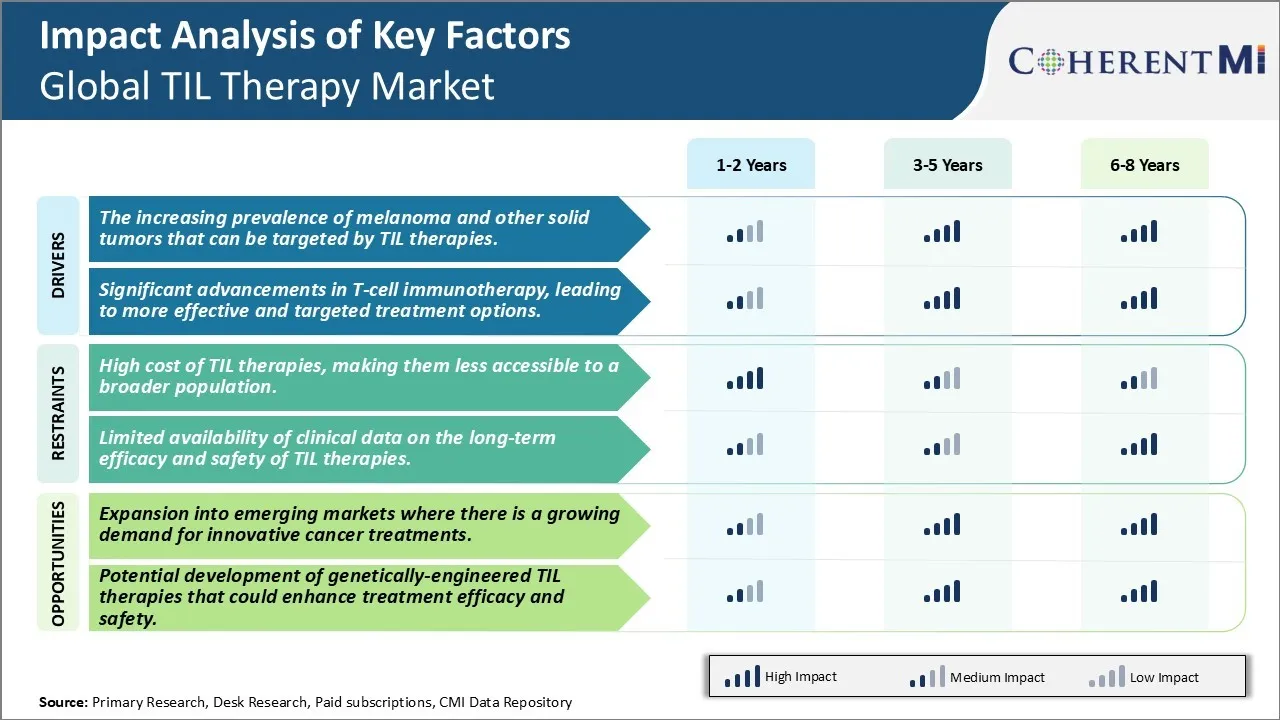Global TIL Therapy Market Trends
Market Driver - The increasing prevalence of melanoma and other solid tumors that can be targeted by TIL therapies
The rising incidence of various types of cancer worldwide has become a serious public health concern. According to estimates, melanoma alone accounts for over 100,000 new cases and over 7,000 deaths each year in the United States. While surgical resection and chemotherapy/radiation therapy have been the frontline interventions for cancer for many years, their effectiveness remains limited, especially in advanced stages. There is a clear clinical need for more targeted and personalized treatment approaches with improved outcomes. This is where TIL cell therapy plays an important role. Several studies have demonstrated the potential of TIL therapy, especially for metastatic melanoma where lymphodepletion followed by TIL infusion has shown response rates of over 50% in clinical trials. Similar results have also been seen in patients with lung and bladder cancer, indicating the broader applicability of this immunotherapy approach. As cancers become more treatment-resistant with current intervention modes, TIL therapy offers promise as a durable treatment alternative that harnesses the body's own immune system to fight tumors in a sustainable manner. With its encouraging efficacy and safety profile established thus far, TIL cell therapy market is expected to flourish further with more research evaluating its use in additional solid tumors like head and neck cancer.
Significant advancements in T-cell immunotherapy, leading to more effective and targeted treatment options:
Cancer research has seen tremendous progress in the area of immunotherapy over the last decade, especially regarding adoptive cell transfer methods. Among these, TIL cell therapy stands out with major advancements that have enhanced its clinical potential. For instance, scientific studies exploring optimal TIL expansion methods ex-vivo have enabled higher yields of anti-tumor T cells for infusion. Advances in predictive biomarkers help identify patients most likely to respond. Second generation manufacturing protocols promise more consistent and scalable production processes. Combination strategies evaluating TILs together with checkpoint inhibitors are yielding encouraging synergistic effects. Moreover, genetic engineering techniques now allow manufacturing of T cells with chimeric antigen receptors or bispecific antibodies tailored against specific tumor antigens for a more targeted approach. All these ongoing innovations are supporting more effective and personalized TIL therapy with fewer side effects. As the understanding of cancer immunology and cell manipulation techniques expand further in the coming years, next generation TIL therapy models will likely emerge, revolutionizing cancer management. This constant evolution in T-cell immunotherapy domain will continue driving significant market uptake of TIL cell therapy worldwide.

Market Challenge - High cost of TIL therapies, making them less accessible to a broader population
One of the key challenges currently facing the global TIL therapy market is the high cost associated with these treatments, which ultimately makes them less accessible to a broader patient population. Developing an individualized TIL therapy requires extracting a patient's own immune cells, expanding them to large numbers in the laboratory, and infusing the cells back into the patient. This highly customized manufacturing process leads to significantly higher costs compared to traditional drug therapies. Currently, the average cost of a single TIL treatment ranges anywhere from US$50,000 to US$100,000 in the United States. While demonstrating promising clinical efficacy against certain cancer types, these costs place TIL therapy out of reach for many patients and healthcare systems globally. The high costs also represent a major barrier to insurers and governments approving wider reimbursement for these innovative immunotherapies. If TIL therapies are to fulfill their potential and reach more patients, providers will need to implement more efficient and cost-effective manufacturing techniques to help drive down overall costs and make these treatments a viable option for a broader population.
Market Opportunity- Expansion into Emerging Markets
One significant opportunity area for companies in the global TIL therapy market is the expansion of commercialization efforts into emerging markets. While currently approved and reimbursed in only a handful of developed nations, emerging economies in regions such as Asia, Latin America, Middle East, and Africa represent a large and growing market for innovative cancer treatments. As economies in these regions become more advanced, healthcare systems are increasingly able to dedicate more resources toward sophisticated therapies. A growing middle class also means more patients are able to directly pay out-of-pocket or get coverage through private insurance for high-cost treatments. With cancer incidence rates steadily rising globally as populations age, the demand for cutting-edge immunotherapies like TIL cell therapies is expected to ramp up significantly in emerging nations. By launching early commercial and clinical efforts catered to these markets, companies currently leading in TIL therapy development can position themselves to capitalize on future growth opportunities and potentially reach a much wider pool of patients worldwide.